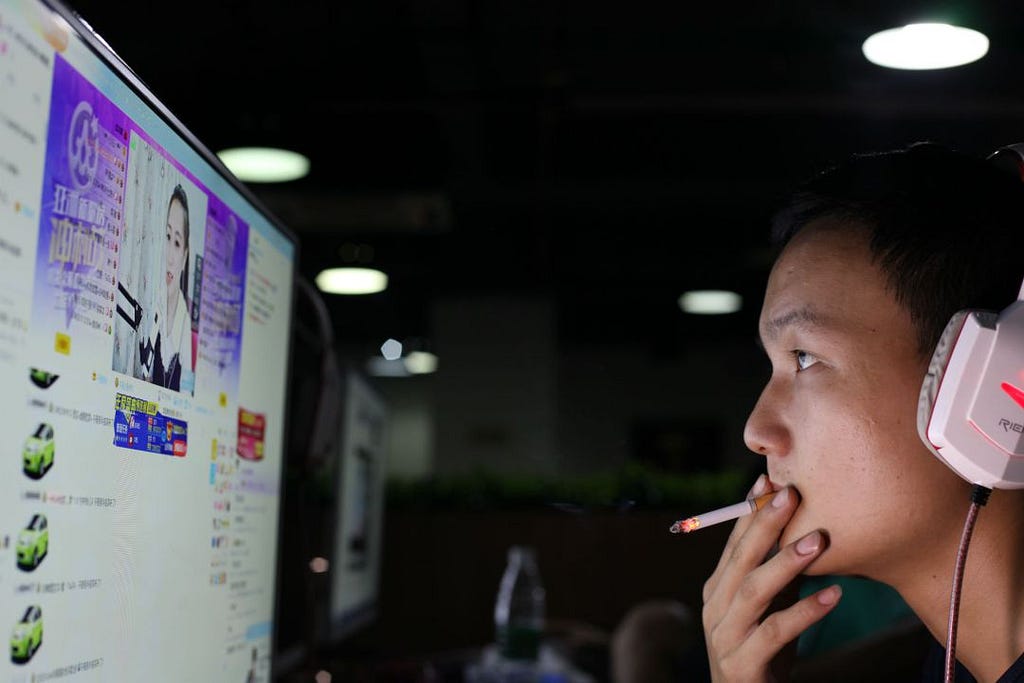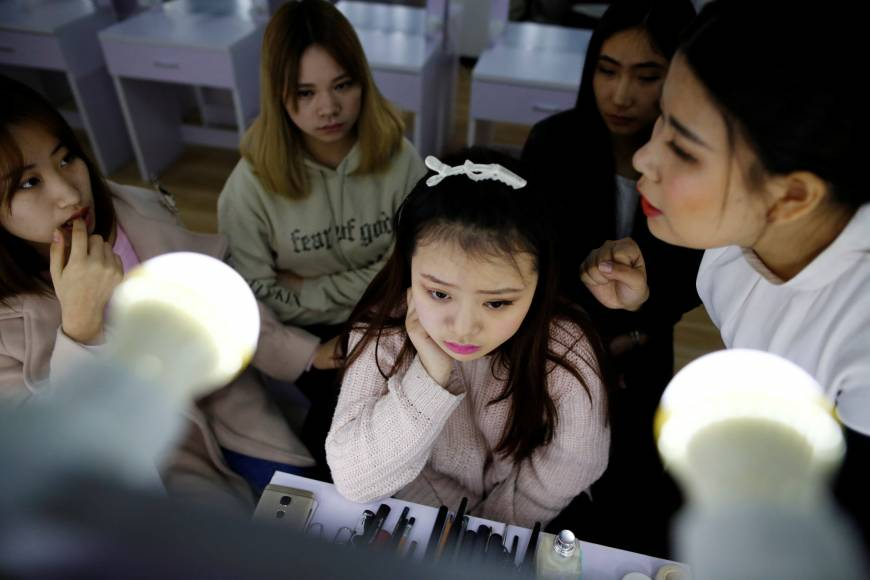Latest news about Bitcoin and all cryptocurrencies. Your daily crypto news habit.
I work at Twitch and helped build Periscope and Facebook Live. So take it from me — when it comes to live streaming, China is at another level. More than 300 million people watch 3.5 million streamers in the world’s most populous country. Here‘s a primer on the Chinese market:
1. Streamer: Young, beautiful, and IRL
 Source: Matjaz Tancic from Motherload
Source: Matjaz Tancic from Motherload
Unlike the US where Twitch is very popular, game streaming only makes up 20% of China’s $5 billion live streaming market. The remaining 80% comes from IRL (in real life) streamers.
 Source: Inke
Source: Inke
According to surveys, 70% of IRL streamers are female and about two thirds are under 26 years old. These young hosts stream everything from singing to just chatting about life. Sounds easy right? But being a streamer in China is a very stressful career:
“I feel the pressure because there are more and more cute girls joining. I used to livestream for 10+ hours every day. Because I know others are prettier and better than me, I have to work harder to be liked by more people.” Source: BBC“[One streamer] wakes up at 9 am and works till midnight every day, with the live-streaming alone taking five to six hours a day. Preparation work, such as hairdos, make-up and dressing up, takes another two hours. She also needs to upload new photos and videos to her account on Weibo and interact with her followers to maintain her fan base.” Source: SCMP
So how much do streamers make for their hard work? Although a few can earn $20,000 USD a month or more, many barely make a living. According to a Tencent survey, only 5% earn more than $1,500 USD, while 70% earn less than $15 USD.
2. Diaosi: Looking for a cure to loneliness

To understand why Chinese viewers like IRL content, you need to understand the term diaosi.
Chinese live stream viewers are 75% male and 70% under age 30. Imagine that you’re a young guy living in Shanghai and making $500 USD a month. You’re from a tier 2 city where your aging parents live. You can’t find a girl to marry unless you own an apartment, but even the cheapest studio costs hundreds of times your income. After a long day at work, you come home to watch live streams.
You’re a diaosi (“loser” or if translated literally, pubic hair). Diaosi watch live streams to forget about their loneliness in real life. They fill streams with endless banter and small gifts to attract the attention of streamers. But gifts from diaosi only make up a fraction of a streamer’s income. The real money comes from…
3. Tuhao: Virtual diamond rings and birthday cakes
 Not an actual tuhao, but you get the idea.
Not an actual tuhao, but you get the idea.
The majority of viewers may be diaosi, but streamers in China are really looking for tuhaos. Tuhaos are the whales of China’s live streaming industry. They have plenty of disposable income and like to spend it on expensive virtual items. The highest priced gift on Inke (China’s #1 mobile streaming app), is a virtual birthday cake that costs $2,000 USD. When tuhaos splash an expensive gift in a stream, they feel great because they get a huge reaction from the streamer and envious cheers from the diaosi. Some tuhaos even ask streamers to meet them in real life. According to one streamer, “There are hidden rules in this world. Tuhao will ask to meet in person, or something else.”
4. Agency: A streaming star factory
 Streamers learning about makeup at a Beijing agency. Source: Reuters
Streamers learning about makeup at a Beijing agency. Source: Reuters
To capture the attention of tuhaos and grow their diaosi following, streamers often work with agencies. Agencies take a cut of a streamer’s income in exchange for services like make-up, equipment, and training. One of the more popular agencies is Redu Media. A video tour of Redu’s office shows a long hallway leading to small rooms full of streamers. Redu offers streamers a salary of $1,500 USD a month. In exchange, streamers get to keep about 20% of their income after Redu and the platform take their cuts.
Some agencies take it a step further. A few won’t hesitate to buy digital gifts with fake accounts to boost a streamer’s ranking on a platform. Others even pay for cosmetic surgery:
“Three Minute TV also arranges cosmetic surgery at partner hospitals for its anchors and arranges small bank loans for the surgery.” Source: Reuters
5. Platform: From hundreds of apps to a few leaders
 A selection of Chinese live streaming apps
A selection of Chinese live streaming apps
At the peak of China’s live streaming frenzy, there were hundreds of companies. Over the past year, the market has consolidated and clear leaders have emerged.
Huya and Inke are two such leaders. Looking through their IPO filings, two things jump out:
- Neither platform is profitable. Despite taking a 60% cut of streamers’ income, both platform lost money in 2017 (-$35M and -$12M USD for Inke and Huya respectively). If the leaders are losing money, no wonder the other platforms can’t survive.
- Virtual goods are the dominant revenue stream. Unlike the US where streamers can earn money from subscriptions (which provides more stable income) and other sources, streamers in China almost entirely rely on virtual goods to make a living.
6. Government: Cracking down on risque content
Since last year, the government has shut down over 400 live apps for hosting content that promotes “violence, pornography, gambling, superstition, and other values harmful to public morality.” Streamers can be banned for suggestively eating a banana or for just being a foreigner. Being banned is a big deal — even a day away from streaming can have a large negative impact on a streamer’s following and livelihood.
So what does all this mean? When I log in to a Chinese live streaming app, I’m reminded of casinos, with each stream being a slot machine. Roses constantly flash on the screen from diaosis while tuhaos would periodically splash sports cars and diamonds (forget sending a regular chat message, you will get ignored). The more money you spend, the more likely you are to get a reaction from the streamer. The cynical might say that this feels like paying for attention. But if this industry helps millions of streamers support themselves and millions more viewers temporarily forget their loneliness — who’s to say that’s a bad thing?
Follow me on Twitter for more about live streaming.
Further reading:
- Jinglan Lin, The Rise and Proliferation of Live-Streaming in China
- Zhicong Lu, A Study of Live Streaming Practices in China
- Peeps, Winning and Losing in Modern China
- SCMP, Confessions of an American Streamer in China
- Slate, A Documentary Reveals Fickleness of Online Fame in China
- TheNextWeb, The Hidden World of Inke
- Inke, Huya IPO filings
A Primer on China’s Live Streaming Market was originally published in Hacker Noon on Medium, where people are continuing the conversation by highlighting and responding to this story.
Disclaimer
The views and opinions expressed in this article are solely those of the authors and do not reflect the views of Bitcoin Insider. Every investment and trading move involves risk - this is especially true for cryptocurrencies given their volatility. We strongly advise our readers to conduct their own research when making a decision.
